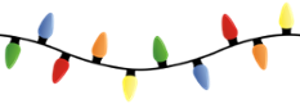Fire Safety: Holiday Decorating Guidelines
Last Updated: April 4, 2017 1:22:47 PM PDT
Give feedback

Know the UC San Diego holiday decorating guidelines.
Festive decorations in the workplace add to the joy of the holiday season. But improper use can result in fires or electrical accidents.
Decorative materials
- Decorative materials are not permitted in corridors. Do not obstruct exit signs, fire alarms, extinguishers, sprinkler heads, or hose cabinets. Best locations:
- Reception areas
- Lobbies
- Foyers
- Break rooms
- All decorative materials, including trees, tree cuttings, artificial greenery, hay, straw, curtains, drapes, hangings, etc., must qualify as one of the following:
- Noncombustible (not all artificial trees are!)
- Inherently flame retardant (the label will say so)
- Treated with a flame retardant solution by a licensed treatment vendor
Trees
- When selecting a natural tree, test for freshness and noncombustibility.
- To test for freshness, lift the cut tree a couple of inches off the ground and bring it down abruptly on the stump end. The outer needles should not fall off in substantial numbers. Inner needles do turn brown and shed naturally each year.
- Buy a tree that's treated with a flame retardant solution. If you're unsure whether the tree has been treated or not, have it processed by a licensed treatment vendor.
- Mount the tree securely in a stand with a water reservoir. Add fresh water daily.
- Remove trees immediately upon any signs of dryness (brittleness, loss of color, falling needles). While freshly-cut trees have some natural flame resistance due to their high moisture content, they soon become extremely flammable when brought inside.
- Consumer-applied flame-retardant coatings do NOT extend the length of time a tree should be permitted indoors.
- Remove natural trees from the building prior to any extended period of vacancy.
Lighting
- Open flames and candles may not be used as decorations in the workplace.
- Use indirect lighting for your decorations whenever possible.
- Natural trees or nonmetallic artificial trees may be decorated with electrical lights. Never use electrical decorations or devices on metallic trees.
- Use only UL-listed light sets that are in perfect condition. Examine holiday lights carefully. If you find any of the following conditions, do not attempt repairs — discard the lights immediately. The cost of new lights is small compared to the increased risk of fire from damaged (even if repaired) wiring. Do not use strings of lights with:
- Broken, frayed, or exposed wires
- Bulbs broken off in the socket
- Loose connections
- Holes from having been tacked or stapled in the past
- Consider LED lights. They dissipate less energy in the form of heat because they use light-emitting diode instead of incandescent bulbs. That makes them less likely to cause a fire, and the reduced power consumption is better for the environment and your pocketbook. While their initial purchase price may be higher, they cost significantly less to run.
- If you install lights, be sure to assign a staff member to turn them off at the end of the day.
Extension cords
- Extension cords are permitted for temporary use only.
- Make sure extension cords are in good condition and UL-listed.
- The extension cord wire should be equal to or larger than the wire you plug into it. If in doubt, use a heavy-duty cord.
- Never tack or staple an extension cord to the wall or woodwork — it could damage the cord and create a fire hazard.
- Make sure cords do not create trip hazards.
- Read electrical safety guidelines for more information.
For more information, contact EH&S Fire & Life Safety, (858) 534-3659.
Note: this page has a friendly link that's easy to remember: http://blink.ucsd.edu/go/decorating